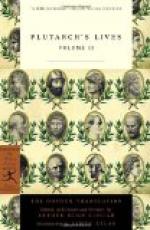[Footnote 210: The Peiraeus, one of the chief ports of Athens, is often used to express the maritime city generally and the lower city, as opposed to Athens, which was called the Upper City. The two cities were united by the Long Walls, about four miles in length.]
[Footnote 211: The Academia, one of the suburbs of Athens, was planted with trees, among others with the olive. It was on the north-west side of the city. In the Academia there was a Gymnasium, or exercise place, and here also Plato delivered his lectures; whence the name Academy passed into use as a term for a University (in the sense of a place of learning) in the Middle Ages, and has now other significations. The Lycaeum was another similar place on the east side of Athens.]
[Footnote 212: This was Epidaurus on the east coast of Argolis in the Peloponnesus, which contained a temple of AEsculapius, the god of healing. Olympia on the Alpheius, in Elis, contained the great temple of Jupiter and immense wealth, which was accumulated by the offerings of many ages. This and other temples were also used as places of deposit for the preservation of valuable property. Pausanias (v. 21, vi. 19, and in other passages) has spoken at great length of the treasures of Olympia. These rich deposits were a tempting booty to those who were in want of money and were strong enough to seize it. At the commencement of the Peloponnesian war (B.C. 431) it was proposed that the Peloponnesian allies should raise a fleet by borrowing money from the deposits




